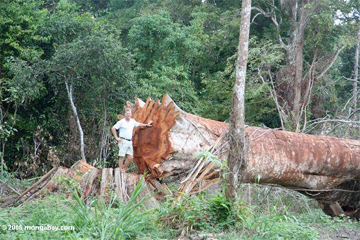A researcher is using carbon and oxygen isotopes to track
the origin of timber as part of a worldwide effort to develop methods
to combat illegal logging.
Dr. Akira Kagawa, a wood scientist with the Forestry & Forest Products
Research Institute in Tsukuba, Japan, has developed a technique that
compares the ratio of various isotopes in tree rings to pinpoint the
geographic origin of timber from temperate climates. The technique
capitalizes on differences in climatic parameters (temperature and precipitation)
over distances — trees that grow in close proximity will show similar fluctuation of stable
isotopes; trees growing at distances of 150-300 kilometers away from one
another other will show differences in stable isotope fluctuation. The process
builds on earlier work that used only tree ring width for determining the
origin of wood.
|
|
Kagawa says the new technique is more precise, but notes that it doesn’t yet
work for tracking tropical timber that lack tree rings. Tropical timber is important because it is the dominant type of wood
in the $10-billion-per-year illegal timber trade He says that improving current isotope analysis technique, sampling other isotopes or combining the technique with others used for determining the origin of wood (including DNA and chemical extracts)
may hold the key for tropical timber.
Kagawa presented his research at the American Geophysical Union’s annual
meeting in San Francisco.
2010-01-07 update: Akira Kagawa and Steven W. Leavitt (2010). Stable carbon isotopes of tree rings as a tool to pinpoint the geographic origin of timber. Journal of Wood Science















